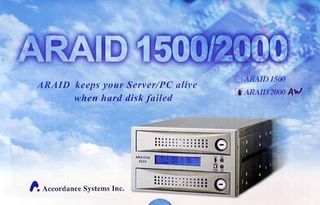Security with Ease: Accordance ARAID 2000
An In-Depth Look At The ARAID 2000

Due to its closed RAID architecture, the ARAID 2000 works completely without additional drivers; the software provided by chipset makers for their controllers is enough. Examples include the Intel Chipset Installation Utility, NVIDIA Forceware, or VIA Hyperion 4in1 driver. For performance reasons, the most current version of these packages should always be installed.
Instead of a special RAID volume signature, traditional partitions are created on the hard drives that are used. Special drivers are not needed to access these partitions, assuming that the drives were initially connected to another computer. Inside the chassis, the ARAID 2000 occupies two 5.25" bays, and two SATA drives are utilized. The maximum capacity per drive is currently 400 GB, using the Hitachi Deskstar 7K400.
The ARAID 2000 is seen on the system as a Serial ATA drive. This means that monitoring the individual drives is not possible without extra hardware and software. To allow this capability, Accordance has added a serial cable, which is routed through the back of the PC using a special bracket, and then hooked up to a 9-pin serial port. A service program uses data from this connection to display the condition of each hard drive. This is functional, but it would be more elegant if users could monitor drive status via USB, as fewer and fewer new systems have serial or parallel interfaces.

The 40-pin ATA port is only used for updating Firmware.
Stay on the Cutting Edge
Join the experts who read Tom's Hardware for the inside track on enthusiast PC tech news — and have for over 25 years. We'll send breaking news and in-depth reviews of CPUs, GPUs, AI, maker hardware and more straight to your inbox.
Current page: An In-Depth Look At The ARAID 2000
Prev Page Guarding Against Hard Disk Failure Next Page Drive BaysMost Popular


